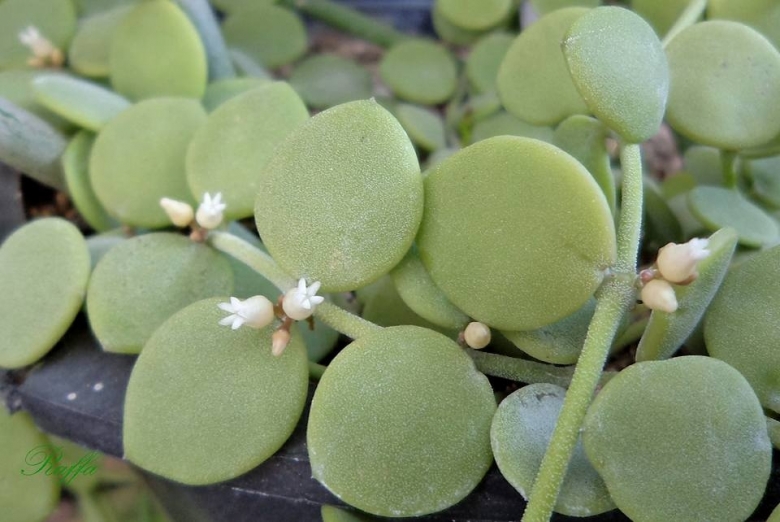
Dischidia nummularia Photo by: Raffa C. Garcia
Origin and Habitat: Australia (Queensland), North East India, Sri Lanka, Bangladesh, Myanmar, China (Hainan), Camboodia, Laos, South Vietnam, Malaysia (Malaya), Indonesia (Borneo, Java, Moluccas, Sulawesi, Timor), Philippines, Singapore. Thailand, Solomon Islands, and Papua New Guinea.
Altitude range: 300-1700 metres above sea level.
Habitat and ecology: Dischidia nummulariaSN|32546]]SN|32546]]SN|32546]]SN|32546]] are often very common epiphytes in sunny and slightly shaded localities in different types of, more or less dry, deciduous open forest and in rainforests, but also in secondary forest and mangrove forest, on roadside trees, in plantations and on limestone hills, often hanging down in long garlands. Unlike other species of Dischidia, which have lens-shaped leaves associated with ant nests, Dischidia nummulariaSN|32546]]SN|32546]]SN|32546]]SN|32546]] has the same type of small lens-shaped leaves, but they provides no nest cavities for ants. The numerous flowers of this species seldom set fruit, but are constantly tended by ants and may function as analogues of extrafloral nectaries.
Synonyms:
See all synonyms of Dischidia nummularia
back
Accepted name in llifle Database:Dischidia nummularia R.Br.Prodr. Fl. Nov. Holland. 461 1810Synonymy: 28
back
Common Names include:
ENGLISH: Button Orchid, String of Nickels
Description: Dischidia nummulariaSN|32546]]SN|32546]]SN|32546]]SN|32546]] is an epiphytic climber-plants, glabrous except for flowers. It has tiny, opposite lens shaped leaves, and is frequently seen on the trunks of trees, resembling numerous hanging necklaces on branches. It is often seen in cultivation despite its inconspicuous yellowish-white flowers.
Stems: Slender, twining or creeping, rooting superficially on the branch of the supporting tree, glabrous to 1.5 m long, internodes longer than leaves.
Roots: Adventitious at the nodes.
Leaves: Tiny, opposite lens-shaped. Petiole 1-2 mm long 1 mm in diameter. Leaf blade orbicular to ovate, 7-14 mm long, 7-10 mm wide, flat, pale olive green to yellowish brown, farinose-white, tips with a minute mucro, base round or shortly cuneate, lateral veins obsolete.
Inflorescences (pseudumbels): Subsessile, glabrous, 1- 6-flowered. Peduncle 1-10 mm long; Pedicels 3-5 mm long, 1 mm in diameter.
Flowers: Sepals ovate 0.5-0.7 mm long, 0.5 mm wide, glabrous. Corolla white or yellowish, 3-4 long, 2-3 mm in diameter, tube 2-3 mm long, 2-3 mm wide, campanulate-urceolate. Lobes ovate-triangular, thickened at middle 2-2.5 long, 0.75-1 mm wide. Corona lobes anchor-shaped, shorter than gynostegium, stalked, apex 2-cleft, widely divergent, lateral arms oblong, pendulous.
Fruits: The fruit are paired spindle-shaped, semi erect, capsules (follicles) 2.5 - 4 cm long, 5-8 mm wide pale green or yellow, glabrous, with the tightly packed seeds inside.
Seeds: 2-2.5 long, 1 mm broad, each of which has a tuft of hair (or coma) about 1 cm.
Bibliography: Major references and further lectures
1) Rintz, R.E. (1980). "The Peninsular Malayan species of Dischidia (Asclepiadaceae)". Blumea 26:81-126.
2) Focke Albers, Ulrich Meve “Illustrated Handbook of Succulent Plants: Asclepiadaceae: Asclepiadaceae”, Volume 4 Springer Science & Business Media, 2002
3) Peter K. L. Ng, Richard Corlett, Hugh T. W. Tan “Singapore Biodiversity: An Encyclopedia of the Natural Environment and Sustainable Development” Editions Didier Millet, 2011
4) Christophe Wiart “Medicinal Plants of the Asia-Pacific: Drugs for the Future?” World Scientific, 11 January 2006
5) Earl of Cranbrook “Key Environments: Malaysia” Elsevier, 22 October 2013
6) Edgar Heim “Flora and Vegetation of Bali Indonesia: An Illustrated Field Guide” BoD – Books on Demand, 09 February 2015
7) Roeland Hendrikus Maria Julien Lemmens, N. Bunyapraphatsara “Medicinal and poisonous plants”, Edizioni 12-13 Backhuys Publishers, 2003
8) Trinity College (Dublin, Ireland) “Notes from the Botanical School of Trinity College, Dublin”, Volume 2 Printed at the University Press, by Ponsonby and Gibbs., 1916
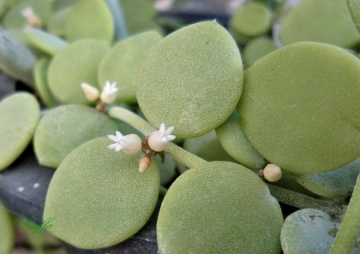 Dischidia nummularia Photo by: Raffa C. Garcia
Dischidia nummularia Photo by: Raffa C. Garcia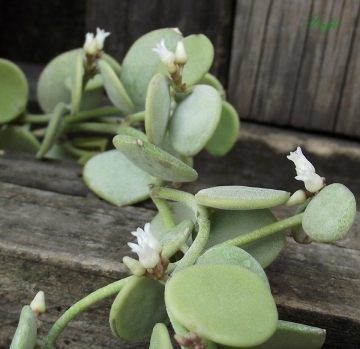 Dischidia nummularia Photo by: Raffa C. Garcia
Dischidia nummularia Photo by: Raffa C. Garcia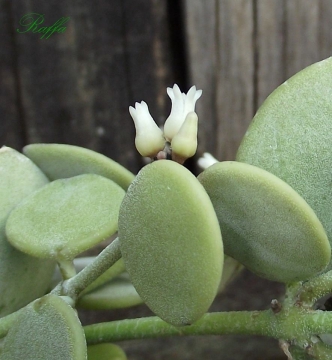 Dischidia nummularia Photo by: Raffa C. Garcia
Dischidia nummularia Photo by: Raffa C. Garcia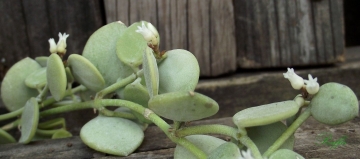 Dischidia nummularia Photo by: Raffa C. Garcia
Dischidia nummularia Photo by: Raffa C. GarciaCultivation and Propagation: Dischidia nummulariaSN|32546]]SN|32546]]SN|32546]]SN|32546]] is a white bloomer that flowers prolifically once established. It is practically impossible to kill and is suitable for dischidia beginners but only occasionally cultivated as ornamental. It is a tropical plant that once again will do much better with some extra warmth and humidity. In cultivation this species adapts to growing in a pot or hanging basket.
Potting medium: Because it is an epiphyte benefits from being potted up in a very well-draining and porous potting medium that allows some air to get to the roots; typical mixes include, peat, with some fibrous soil and sand along with large-grade drainage material such as perlite, pumice, or ceramic balls. Often specialized growers either use only chopped coconut husk or a good orchid potting mixture for growing their plants. The medium needs to be moisture-retentive.
Watering: This species appreciates moisture and can handle being over watered better than any of them, so it should be kept moist, but can dry up a bit from time to time without being damaged by it. Water regularly in summer, but do not overwater ( wet-sensitively) and let the plants to dry out between watering and then water again. Its roots are easily lost in pots that stay damp for any length of time. Keep quite dry with ample airflow in winter (It would probably tolerate one watering a month). In the rest period no high atmospheric humidity. Care must be taken with watering as they tends to become swollen and untidy in growth habit if given too much water and shade. This plant will suffer considerably in the dry environment of northern centrally heated homes in the winter. If you want this plant to be happy in the winter grow it in a room with lots of humidity.
Fertilization: During the growing season enrich the soil using a fertilizer rich in potassium and phosphorous, but poor in nitrogen, because this chemical element doesn’t help the development of succulent plants, making them too soft and full of water.
Exposition: The best place for Dischidia is partial shade or bright shade, but grow well in indirect sun. Midday sunlight in summer can burn the leaves. Tends to bronze in strong light, which encourages flowering and heavy leaves production.
Temperature: The ideal for this species, temperature is between 20 and 25 but never below 10ºC. (Outdoor zone: At least Zone 10, possibly cooler).
Spring: When winter ends and they begin to grow again, they will require much water and soaking the pots will no longer put the plants at risk for rot. In the spring they will grow well in partial shade and leaving them out in the rain may provide them with the water they need.
Summer: In the summer months they will tolerate heavy rain, but will be just as happy if the season is dry. They will tolerate hot weather outdoors as long as they are kept in strongly filtered light and this will encourage them to flower. They also enjoy some fertiliser. Moving the plants as they are developing buds may cause them to spontaneously abort the flowers all together.
Autumn: In the fall keep them outdoors until the night time temperatures drop below the 10°C.
Winter: Winter care presents no problems at 12° C with plenty of light. In winter be sure to take extra precautions to keep them dry, because damp cool conditions when the plants are resting is an invitation to fungal infections, but - according to temperatures –some occasional lit watering may be useful.
Maintenance:** Prune the plant lightly to keep it tidy.
Repotting: In any season it's best to lay the stems out for several days before replanting them and then pot them only in dry soil and withhold any water until they begin to shrivel or start growing again. Re-pot every 2 years.
Pest and diseases: They are generally fairly easy to grow, especially if kept pest-free. They are very susceptible to stem and root mealy bug, which can be fought easily with common pesticides, and damage from these may well initiate fungal attack. Any time when there is a dead or dying stem in the pot it is important to remove it immediately and completely before other healthy stems can become ill too, isolate the healthy parts, dry them off, and re-root them in new compost.
Uses: Dischidia nummulariaSN|32546]]SN|32546]]SN|32546]]SN|32546]] R. Br. is used to heal painful wounds caused by certain poisonous fish; the leaves and latex are used to treat sprue.
Propagation:*** This species propagates readily from stem cuttings, whether in water, in soil or in a sterile medium (such as perlite).














